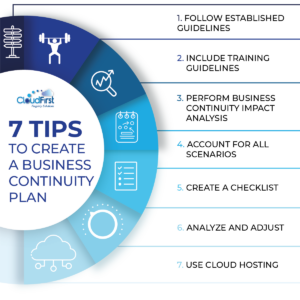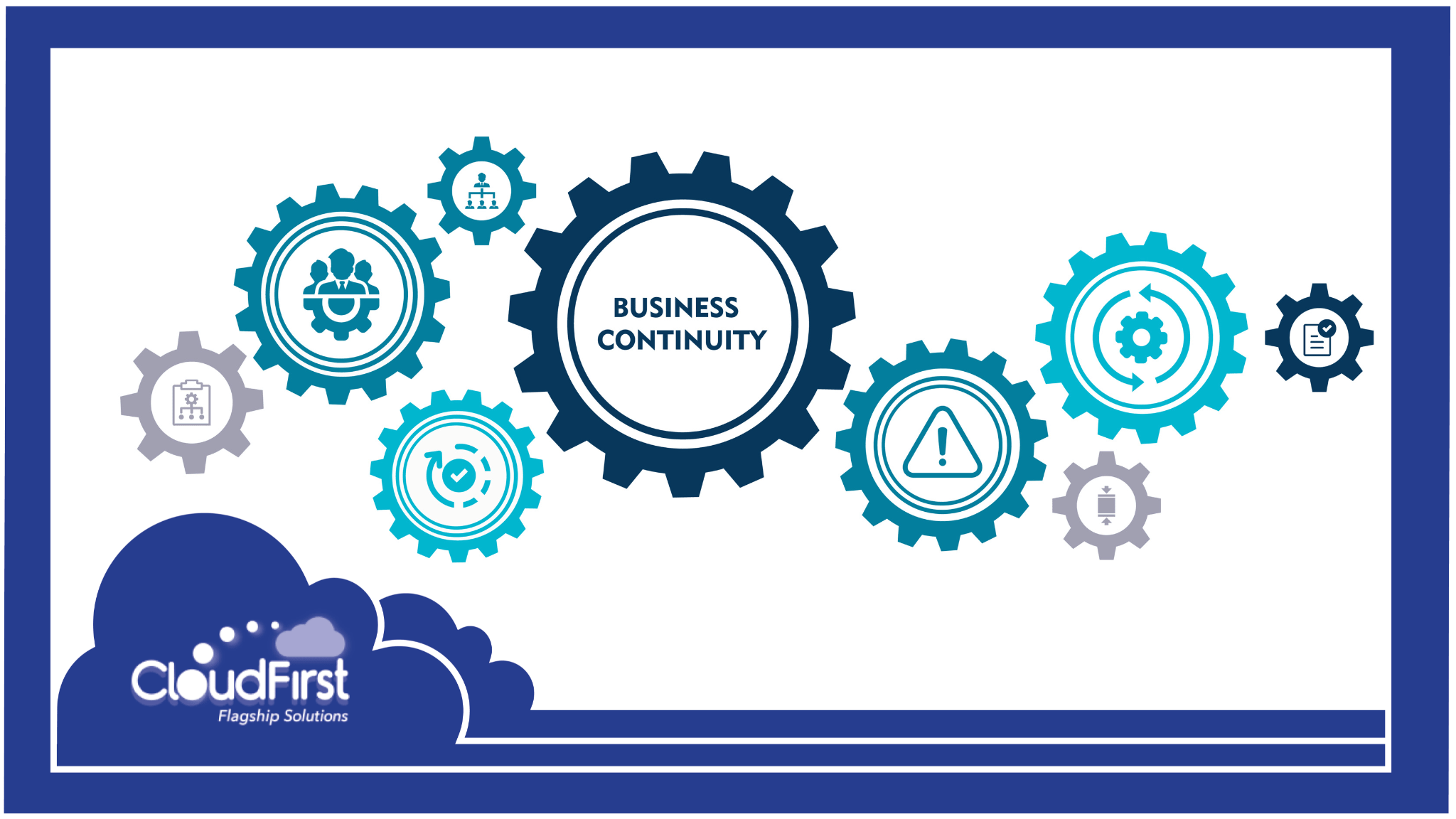Imagine what it would be like to have your business uprooted in the blink of an eye. That’s precisely what can happen if you’re the victim of a cybersecurity attack. And without a plan to fall back on, picking up the pieces will be a struggle. But worse, it could also mean closing your doors, temporarily or permanently.
A business continuity plan (BCP) prevents that by ensuring your business has an actionable plan when things go wrong. However, according to a study done by AT&T published in the Hartford Business Journal, nearly one in five businesses don’t have any set business continuity plan.
And if you think these problems are just for big businesses, think again. The University of North Georgia states that “forty-three percent of cyber attacks target small business,” and even more troublesome data reveals that “there is a hacker attack every 39 seconds.”
In the business world, “It’ll never happen to me” is a phrase you never want to have to eat. Thankfully, with a solid BCP, you won’t have to.
What is business continuity planning?
Business continuity planning has one goal in mind: mitigating the risk of cyber threats and other disasters. Such crises, like natural disasters or cyberattacks, could have extreme consequences for your business, especially if yours is a small or medium-sized business that doesn’t have the same firepower as large corporations.
But even corporations have had to learn this lesson the hard way, and it’s led to catastrophic consequences. In January 2023, the Notice to Air Missions (NOTAM) database, a system the Federal Aviation Administration (FAA) uses to communicate hazards and runway closures to pilots, went down for hours, forcing thousands of flights to be grounded or canceled.
The NOTAM system was painfully outdated, which would have been easier to discover and address with a BCP. BCPs require frequent testing, maintenance, and updating, and it was clear that the FAA’s outage occurred because the agency was unaware of how badly this system was lacking.
Risk management is crucial to keep your business afloat during a crisis. But business continuity planning goes beyond risk management; it puts those risks into context by testing the plan and reviewing the outcomes to ensure they work as intended.
Why a business continuity plan is important
No business is safe from threats like today’s sophisticated hackers and severe weather. Because BCPs leave no stone unturned, they’re essential for any business that wants to continue operations no matter what obstacles it’s facing.
Every company is at risk of being hit by ransomware. The only thing worse than waking up to find that all your files have been encrypted is realizing you don’t have a backup plan.
BCPs are also effective during power outages, natural disasters, and technology failures from user errors or outdated software, as in the case of the FAA fiasco.
The bottom line? BCPs save money and time by reducing risk and incorporating ample support. And if you happen to be one of the unlucky ones to experience a crisis, you’ll be grateful you invested in a BCP.
The difference between a BCP and disaster recovery
Disaster recovery strategies are vital, so you might prioritize a DR plan over a BCP. And there’s certainly merit to having both; there’s no such thing as being too ready to expect the unexpected.
DR plans mainly emphasize issues with technology, primarily training IT on how to address problems with data as they arise. They’re also meant to address the high cost and time sink that go along with the disaster recovery process, especially those that incorporate cloud-based data backups. A BCP, however, is a more holistic cybersecurity and disaster plan, encompassing every department in the business.
Having everyone involved in handling a disaster makes it much easier, since it means there’s less of a chance that someone won’t know what to do in a crisis; everyone should be on the same page, because everyone in the business is affected.
7 tips for establishing your own BCP

Even though BCPs are complicated and cover a lot of ground, starting one for your business is easier than you think: all you need is some guidance and context. Here are seven tips to help you start.
1. Follow FINRA guidelines
The US government authorizes the Financial Industry Regulation Authority (FINRA) to enforce rules for brokers and broker-dealers. That might be their primary purpose, but they’re also an incredible resource for businesses, offering everything from compliance tools to e-learning courses.
Reviewing FINRA’s Rule 4370 is a good jumping-off point for establishing a BCP. It outlines the minimum requirements for a sufficient BCP. The rule “gives a firm flexibility in designing a BCP,” making it one of the best resources for businesses of any size starting out with a new BCP.
For example, the rule’s minimum requirements can help you create a solid base for your BCP. Section C lists these requirements, many of which a business owner might not initially consider for their BCP, like the potential need for an alternate physical location for employees during a crisis.
2. Include training guidelines
BCPs won’t do much good if the people implementing them don’t know where to begin. Businesses should always have details on how to train new hires and current employees to execute the BCP during a crisis. Doing so ensures that everyone can promptly address issues, no matter who enters or exits your business.
Leadership should also be well versed in the business continuity plan, because they’re ultimately responsible for keeping the business running. Having a good handle on how everyone should carry out the BCP will allow leadership to recognize where to improve or adjust the training process.
3. Don’t forget the BIA
A BIA, or business impact analysis, outlines what disruptions could cause a business to go off the rails and what could be affected. Ready.gov says a business impact analysis “predicts the consequences of a disruption to your business and gathers information needed to develop recovery strategies.” These specifics include the timing and duration of the disaster as well as a detailed risk assessment for avoiding disruption to business operations.
While there’s some overlap in how you’ll use them, a BCP and a BIA are different. The BIA focuses on the potential risks and their outcomes. A BCP focuses more on outlining the processes and procedures to protect your business should the risks come to pass.
FEMA’s worksheet is a thorough and detailed step-by-step guide for establishing a sound BIA. They’ve designed the worksheet specifically to help guide businesses through the potential financial and operational impacts of various emergencies in an easy-to-digest way.
4. Account for all scenarios
Be thorough when considering what could go wrong; take the time to brainstorm all the possible scenarios and role-play the outcomes. The more exhaustive you are at this stage, the less surprised you’ll be in a crisis and the more apt you’ll be to manage it.
You can also get inspiration from examples of BCPs like these. A business continuity plan template is particularly beneficial if the business it’s based on is in the same or a similar industry as your business. It could help smooth out your plan and address some problems you might not think of yourself.
5. Create a checklist
Outlining a plan in detail is essential. But in the event of a crisis, so is readability and accessibility. If you keep the necessary information in a checklist, everyone has easy access to crucial details like emergency contacts, resources, and timelines.
It’ll help everyone involved see what needs doing at a glance while ensuring they miss no steps in executing the BCP.
6. Analyze and adjust
The BCP doesn’t have to be perfect at first. In fact, you should expect to make changes to it regularly.
Businesses grow and change, so their approach to business continuity planning will need the flexibility to grow with them. Deliberately plan to test your BCP, review what worked and what didn’t, and adjust as needed.
7. Take advantage of cloud services
By automatically backing up mission-critical data and applications with a trusted cloud provider, your digital assets are safe no matter what happens. Restoring backups from the cloud is an essential part of a strong BCP.
Be ready for anything with a better BCP

A business continuity plan could be the difference between going out of business and continuing operations. Safeguarding your business from cyber attacks and other disasters isn’t just a good idea; it’s vital to your survival in today’s unpredictable world.
A good BCP can help you attain peace of mind, while a smart cybersecurity strategy will protect it. Learn more about safeguarding your network, data, and IT infrastructure by reading our free ebook, the Business Leader’s Guide to Cybersecurity and Data Protection Strategies.

